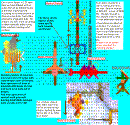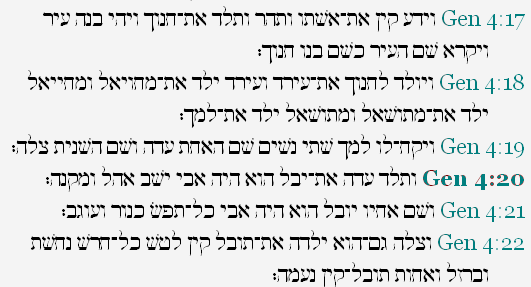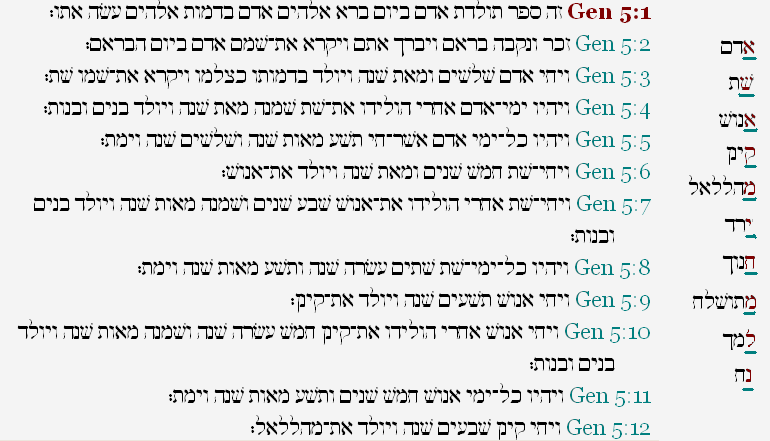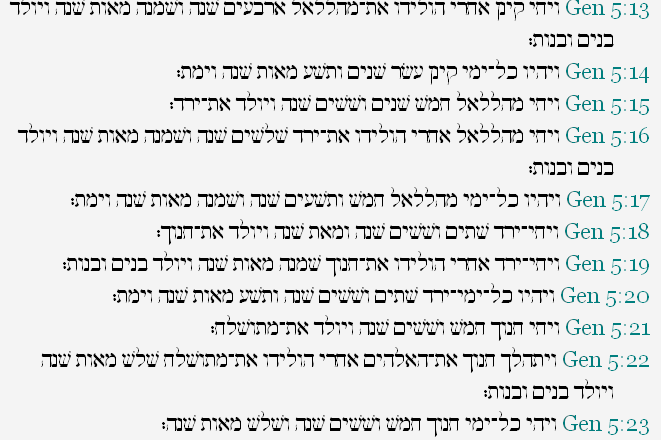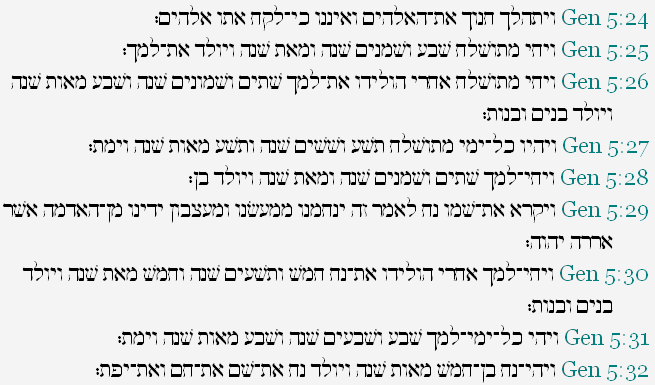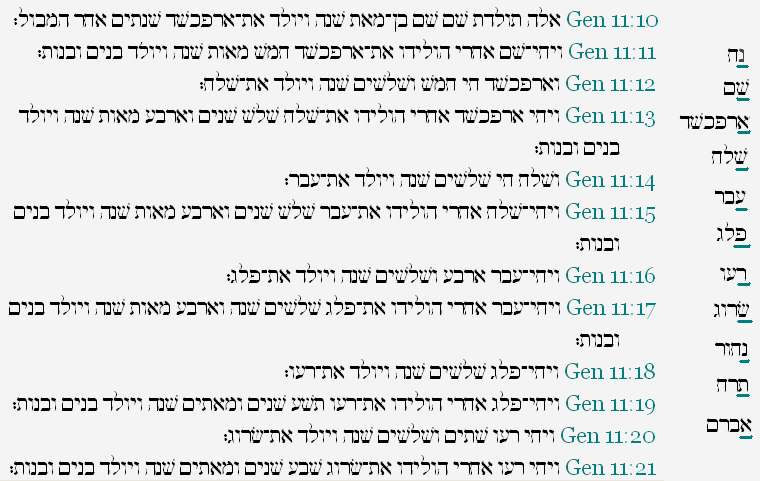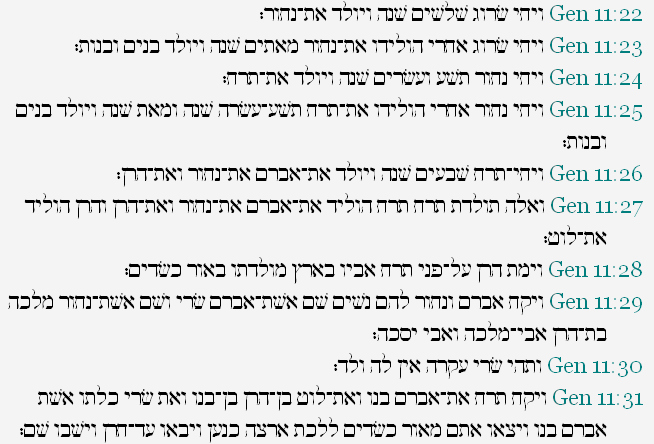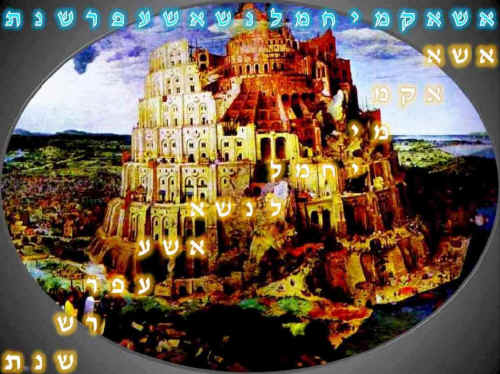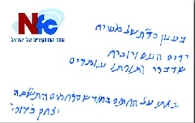The Full Reading
(Three tiered acrostic:
Black = tier one; Blue = tier two; Red = tier three.)(Cain's line)
"I will take peoples for me out from you (m. or f.) ---
the one hung low (or, "impoverished") for the sake of all!I will offer up the one thrust down (or, "crushed," Gen. 3:15),
O mother!"
(Seth's line)
"I will forgive those risen up against me, showing compassion
by lifting up a second time (or, "forgiving again") those who are of dust.
I will be offered up like a fiery bronze serpent or a moth on fire!"I will receive their (offerings) with rejoicing!
I will look upon them with favor!I will forgive!
Cain's Line
(I.e., the ungodly line.)
Genealogy of Adam to Jabal (Cain's line)
(Tier one of acrostic)
Name Hebrew
First-letter acrostic:
Adam down to Jabal
Hebrew
Last-letter acrostic:
Adam down to JabalAdam ¯ I will take
¯ from you (Aramaic)
Cain Enoch Irad ¯ peoples (pl.)
¯ one hung low
(or, "impoverished")
*Alternatively, the last letter in Methusael can adjoin below changing the meaning only slightly. It would instead read "for all"
, and its sub-acrostic would read "being hung low".
Mejujael Methusael * Lamech ¯ to me,
¯ (because) of all. (or, "for all"
.)
Jabal
Genealogy of Adam to Jabal (Cain's line)
(sub-acrostics)(Tier two of acrostic)
¯
I will offer up
(or, "I will make high")
¯ *
(the) one being thrust down,
(or, "one crushed")* (or as "mdl" instead of "mdk", Hof. verb,
= "one being hung low", or, "lowly", "poor".)Genealogy of Adam to Jabal (Cain's line)
(Tier three of acrostic)
O' mother!
Seth's Line
(I.e., the godly line.)
Genealogy of Adam to Abraham (Seth's line)
(Tier one of acrostic)
Name Hebrew
Acrostic: Adam down to Terah/Abraham Acrostic: Abraham back to Shem/Noah Adam ¯ I will forgive
(or "I will bear up")
Seth Enosh Kenan ¯ my enemies,
(lit. "my up- risers")
Mahalalel Jared Enoch ¯ having compassion,
Methuselah Lamech Noah ¯ forgiving
(or "bearing up")
Shem of (on) fire!
Arphaxad Shelah ¯ those of dust
a moth
Eber Peleg as a fiery serpent,
(or "a bronze serpent," or "a seraph," or, "a burning one.")Reu Serug ¯ a second time.
(Written defectively: Similar example, "third-time," Ezek. 21:19)
Nahor I will be offered
(or, "I will offer/give")
Terah Abram Name Hebrew
Acrostic: Adam down to Terah/Abraham Acrostic: Abraham back up to Shem/Noah
Genealogy of Adam to Abraham (Seth's line)
(sub-acrostics)(Tier two of acrostic)
¯
I will receive them (with) rejoicing!
(i.e., their offerings {f. pl.})
I will look with favor!
(Aramaism, 'aleph' for letter 'he')
Genealogy of Adam to Abraham (Seth's line)
(Tier three of acrostic)
I will forgive!
The imagery of what the acrostic says strongly alludes to the Garden-of-Eden narrative, especially the creation and fall of man, and of the offerings of Cain and Abel and the death of Abel at Cain's hands. The Garden-of-Eden narrative is where the first part of our genealogy is found, along with the genealogy of Cain's line. This first half of our genealogy is used to conclude the Eden narrative (Gen. 5), and it leads into the Flood narrative. The remaining 10 names of the genealogy form a transition from the Flood account to Abraham, the man of faith, (Gen. 11).
Just one note is perhaps necessary: The words "a second time" clue us into the fact that Christ is the second Adam in that just as Adam slept and then rose from his sleep, so did Christ; and as Adam was forgiven by vicarious substitution --- he was clothed with an animal skin--- even so, Christ is that substitution, (ICor. 15:45).
The Trinity: (Me, You, and Him)
The acrostic is addressed to "you", which is singular and is masculine or feminine. The "you" of the acrostic appears to be addressed to both the women (Eve) and to her sons collectively (Abel and Seth) as types of Mary and Jesus. Moreover, the "you" is ambiguous so that it may also refer to the one speaking, (that is, the "I" of the "I will...", i.e., to God Himself). The "I" is also the "one" being "offered up", and yet he is separate from the one being offered up. But how can that be? It could be true of no other than God Himself. God the Father is offering up God the Son as an offering. The Two (and Three) are One, which is true of the doctrine of the Trinity. As Jesus said, "I (the Son) and the Father are One!" (John 10:30, cf., 10:36-38).
It seems to me that what is implied here is that father Adam and mother Eve and their son(s) Abel/Seth are together a type of the Trinity. (Abel/Seth are explained next.) This would agree with the text that says concerning Adam and Eve that "the two will become one flesh" (Gen. 2:24), one flesh also implying the product of one flesh, that is, a son. We have, then, in Adam, Eve, and son a type and shadow of the Trinity. This should not surprise us since the two (and three) were also made in His image and are collectively called "Adam," (Gen. 5:1-2 with Gen. 2:21-24), similar to how the New Testament refers to the Father, Son, and Holy Spirit collectively as (One) God. (God is "Elohim" in Hebrew, and is plural, yet One God!) The three-tiered acrostic even maintains the correct order of the Trinity as Father, Son, and Holy Spirit!
"I (the Father) will lift high the (Son) thrust down,
O mother (type of the Holy Spirit)!"
Note that in the genealogy of Luke, Adam is called "the son of God," (Luke 3:38, "...the son of Seth, the son of Adam, the son of God.")
Abel and Seth together a type of Jesus the Son:
Eve had three sons by name. The acrostic appears to be addressing both Abel (whom Cain slew) and Seth in the sense that these two are foreshadows of the one Christ, that is that they represent Jesus as slain (Abel) and Jesus as risen (Seth).
The Curse Undone:
The acrostic prophesies the undoing of the curse laid upon Adam and Eve. (The curse fell in this order: First the serpent, then the women, and then the man. The acrostic code undoes the curse in the opposite order; the man, the women, and then the serpent. However, the curse upon the serpent is not lifted, but rather the serpent (and moth) reduced to dust become a figure of Christ cursed "for all men" upon the cross.) Moreover, the address to each of them reminds us of their individual curse, "man is brought low/impoverished (to the dust) ("from dust you came and to dust you shall return!"; the women is called "mother" (your pain will be greatly increased in childbirth!" and dust is mentioned just before the serpent, ("and you shall eat dust...").
The acrostic is framed around seven "I will's", with the middle one understood as a qal passive (or hof.) rather than an active verb as the rest. This highlights the central thought of being offered up as a curse to undo the first curse, that is, substitutionary sacrifice. Moreover, 1 and 3 bracket the first three "I will's" and likewise, 5 and 7 bracket the last three "I will's" using the very same verbs. This internal structure aids in interpretation by paralleling each key thought and reinforcing them. For example, line one is in parallel with line five and thus suggests that the "offerings" being accepted by God are in fact the "peoples" themselves, that is, "living sacrifices" taken from both Jew and Gentiles.
The Acrostic in Full
(Three tiered acrostic: Black = tier one; Blue = tier two; Red = tier three.)
See below link for elaboration.(Cain's line)
"I will select peoples for me out from you (m. or f.)
--- the one hung low (or, "impoverished") for the sake of all!I will offer up the one thrust down,
O mother!"
(Seth's line)
"I will forgive those risen up against me,
showing compassion by lifting up a second time (or, "forgiving again") those who are of dust.I will be offered as a fiery serpent or a moth on fire!"
I will receive their (offerings) with rejoicing!
I will look upon them with favor!I will forgive!
Formation of the Acrostic:
It is my personal belief that the organization of this entire three-tiered acrostic, made up of seven "I will" declarations and composed from three genealogies and 27 names (3 x 3 x 3), is using a format intended to reflect the image of the perfect (7) Triune (3) God! Note the following:
The first and last letters form the first acrostic
The second acrostic begins at Adam and ends with Terah (and thus begin with the acrostic-letters Aleph and Tav in Hebrew, but are Alpha and Omega in Greek),
Then the code reverses direction reading backward to the middle of the genealogy, (i.e., to Noah's son Shem)
Compare this to the genealogical declaration about the ancestry of Christ as found in the book of Revelation where Jesus is called, "The offspring of David".
"I am Alpha and Omega, the beginning and the ending, saith the Lord, which is, and which was, and which is to come, the Almighty." (Rev. 1:8.) (I.e., the middle [present], beginning, and ending in time.)
"I am Alpha and Omega, the beginning and the end, the first and the last... I am the root and the offspring of David,..." (Rev. 22:13,16)
The seed of the women crushes the serpent's head!
The Seven "I will's"
1 I will take... 2 I will lift high... 3 I will forgive/bear... 4 I will be given/offered... 5 I will take... 6 I will favorably-look... 7 I will forgive/bear.
The seven "I will's" of the acrostic undo the "I will's" of the cursing. This "seven times" speaks the opposite of the curse of Gen. 4:15, "And Jehovah said unto him, Therefore whosoever slayeth Cain, vengeance shall be taken on him sevenfold." And Lamech, seventh from Adam, said:
"...For I have slain a man for wounding me, And a young man for bruising me: If Cain shall be avenged sevenfold, Truly Lamech seventy and sevenfold," (Gen 4:23-24).
Thus, Lamech expects to be avenged not just seven times, but repeatedly. And so the acrostic picks up on this. Three times the acrostic speaks of forgiveness, and where it reads, "...forgiving again those who are of dust," it seems here to carry the sense of "forgiving repeatedly," as Jesus said, "till seventy-times-seven."
"Then came Peter and said to him, Lord, how oft shall my brother sin against me, and I forgive him? until seven times? Jesus saith unto him, I say not unto thee, Until seven times; but, Until seventy times seven," (Matt.18:21-22).
Since the acrostic is based upon three genealogies, the last two in groups of 10 generations each, and since a generation can be viewed as 100-years long (Gen. 15:13), it seems to me that the seven "I will's" roughly follow the plan of the ages spanning 7000 years. Thus, from David/Solomon to Christ 1000 BC to AD 1/30 would roughly represent the fourth (or middle) "I will", and so forth. Noah's (three-tiered) ark presented as "lifted high" above the 'deep' wherein "all" in the ark are saved appears to be part of the focus of lines one and two. (Note that Jesus rose from the dead on the anniversary of when Noah's ark landed upon Arafat. As said before, Noah is a type of Christ. Moreover, 8 people were saved on the ark, (3 children of Noah with their wives, plus Noah and his wife; see numeric of line two), and the format of the three tiers of the first genealogy (that consists of 8 names) found in lines one and two are composed of 8 + 8 + 8 letters.
The 7000-year Plan of the Ages
Based upon the 10 + 10 generations (of 100 year-generations)
as deduced from the genealogy of the acrostic!
1 (Three-tiered acrostic for Cain's line) I will select peoples for me out from you, --- the one hung low for the sake of all! (8 + 8 letters)
Adam (and Eve) to Noah 2 I will lift high the one thrust down, O mother! (6 + 2 = 8 letters) Noah (and flood) to Abraham (and Sarah) (Sarah is called, "the mother of us all" in Galatians.)
3 (Three-tiered acrostic for Seth's line) I will forgive those risen up against me, showing compassion by forgiving again those who are of dust.
Abraham to King David
(Includes the giving of the law of Moses and priestly system that supplies the means to forgive transgressors of the law.)4 I will be offered up like a fiery bronze serpent or a moth on fire! David to Christ (Jesus hung on cross)
5 I will receive their (offerings) with rejoicing! Church age 6 I will look upon them with favor! Church age 7 I will forgive. Millennial reign of Christ
